Text
Some fun facts about...
MYST (1993)
1• Island Exploration: The game is set on a mysterious island called Myst, and players explore different Ages by solving puzzles to progress.
2• No Character Interaction: Unlike many games, Myst doesn't feature direct interaction with characters. Instead, players interact with the environment and discover the story through journals and clues.
3• Best-Selling PC Game: Myst held the title of the best-selling PC game until it was surpassed by "The Sims" in 2002.
4• Influential Graphics: The pre-rendered graphics in Myst were groundbreaking at the time, contributing to the game's immersive atmosphere.
5• Multiple Endings: Depending on the player's choices throughout the game, there are multiple endings, adding to the replay value.
6• Minimalistic Soundtrack: The game's music, composed by Robyn Miller, is minimalistic but iconic, contributing to the overall ambiance of the game.
7• Expansive Franchise: Myst spawned several sequels, spin-offs, and even novels, expanding the lore of the original game.
8• Cyan Worlds: The game was created by brothers Rand and Robyn Miller, co-founders of Cyan Worlds. They had a significant impact on the development of the adventure game genre.
9• First-Person Perspective: Myst popularized the first-person point-and-click adventure genre, influencing many games that followed.
10• RealMyst: In 2000, a real-time 3D version of Myst called "RealMyst" was released, allowing players to explore the island in a more immersive way.
0 notes
Text


Front and back cover of "The Book of Atrus" by Rand and Robyn Miller and David Wingrove published in 1995.
0 notes
Text
Do you know that Myst had to have its series of comics?
Don't worry, not many know this!
Dark Horse Comics published the first issue in the '90s... And there was only another one after that, not even linked to the first.
It was meant to show what happened before the event narrated in the game but was an absolute flop.
"The Book of the Black Ships" showed Sirrus and Achenar being... Well, themselves, so two brothers that are always on the brink of making some disasters.
The real problem? The Publisher switched the two boys' names and personalities and when Cyan asked them to correct those ENORMOUS mistakes they replied something like "Nah", so Cyan canceled the contract.
If you want to read it anyway, I got a pdf just for you!
6 notes
·
View notes
Text
"The graphic adventure that shook the world"

"You can't get killed, nor can you do anything that will automatically lose the game, your new world is a series of bewildering enigmas that when added together become Myst."
- Barry Brenesal, 4 stars review on PC Magazine, 1994
Image and article from pcmag.com
0 notes
Text
The Basics of D'ni Grammar
(research by Richard Watson)
D'ni is not an Earth language, but because the D'ni are so similar to humans physically and mentally, their language has similarities to some of our native tongues.
D'ni is often compared with Hebrew, since the two languages have similar characters and sounds. But there are many differences, with the most obvious one being that D'ni is written left to right, unlike Hebrew.
The D'ni alphabet has 24 characters, but there more than 24 consonants. These are created by adding indicator marks to a letter. For instance, the character for a "v" sound is the same as the character for a "b," only the "b" has a dot over it. Generally, any consonant without a dot is a fricative, meaning it's produced by air passing continually between the tongue and lips. A consonant with a dot over it contains a stop, meaning that the air is cut off. in the case of a dotted "v," the air is stopped by the lips. By adding indicators to their vowels, D'ni's six vowel letters are expanded to eleven vowel sounds in their spoken language.
D'ni follows a familiar noun-verb structure. Adjectives follow the nouns they modify. Adverbs follow the verbs they modify. Quantifiers such as "very," "extremely," and "really," which add emphasis to phrases, are indicted by numbers from one to twenty-five. The higher the number, the stronger is the emphasis. For example, the phrase "I am a little tired" in D'ni becomes, "I am tired to two." "I am very tired" would be. "I am tired to twenty." To exaggerate something, the D'ni would use a number over twenty-five. "I am incredibly tired," in D'ni could be written or spoken as, "I am tired to thirty."
There are a number of important prefixes and suffixes in D'ni. Verbs use a suffix to indicate both number and person (this is similar to Spanish). For example, the D'ni word for eat is "rees," which is the form it takes when you say "I eat." The suffix "en" is added to indicate that he, she, or it eats, "rees-en." "They eat" uses the suffix "eet." "rees-eet." "We eat" uses "et," "rees-et." "You eat" (singular) uses "em," "rees-em," "You eat" (plural) uses "tee," "rees-tee." You can change this phrase to a command by adding the additional suffix, "ah." To order an individual to eat, you would say, "rees-em-ah!"
Verbs use a prefix to indicate the past, present, and future. To say that you have finished eating, the phrase is "ko-rees." To say that you are currently eating, the phrase is, "do-rees." To say that you will eat later, the phrase is "borrees." Other forms of the suffix are:
• kodo (past progressive): kodo-rees (I was eating)
• le (perfect): le-rees (I have eaten)
• kol (past perfect): kol-rees (I had eaten)
• bodo (future progressive); bodo rees (I will be eating)
• boko (future perfect): boko-rees (I will have eaten)
• bodol (future perfect progressive):
bodol-rees (I will have been eating)
Other common prefixes are "re" for "the." The D'ni word for "book" is "kor," so to indicate "the book," the phrase is "re-kor." The word "and" is "ga," so to indicate "and the book, you would say "ga-re-kor." Suffixes can indicate ideas such as plural and possession. To make a noun plural, add "tee" to the end.
The word for "books" is "kor-tee." To indicate possession, add the suffix "akh," which roughly corresponds to "of." The phrase "Gehn's book," in D'ni is structured, "book of Gehn," and is written, "kor-okh Gehn." An adjective, such as "garo" ("mighty"), can be changed to a noun with the suffix "th," as in "Garoth" (Mighty One). You can change the same adjective into an adverb with the suffix "sh," "garosh," as in "mightily." There is also a special set of characters called the "Garo-hevtee," "Great Words." These symbolize important ideas of groups of words.
From " From Myst to Riven: The Creations and Inspirations" (1997)
35 notes
·
View notes
Text
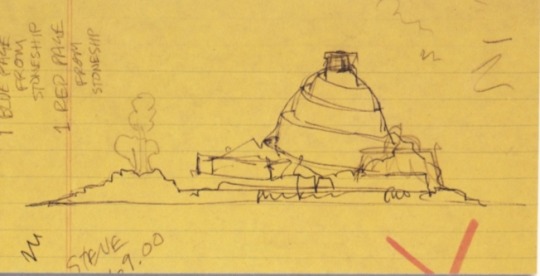



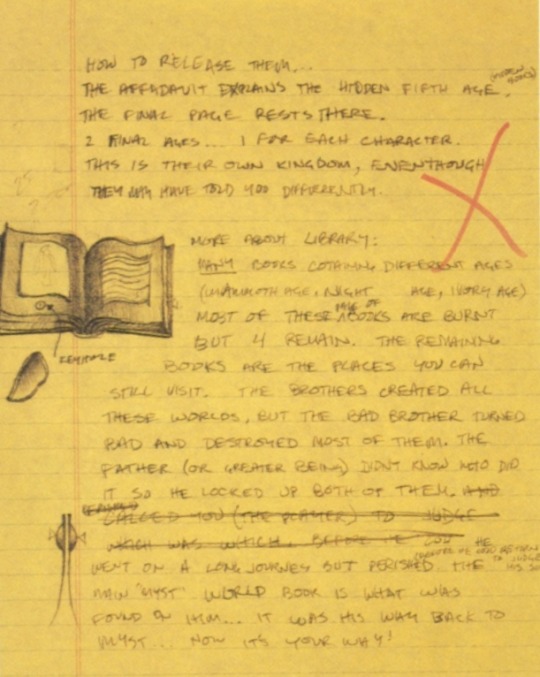
Bless your dash with some flaming (well not literally, thanks haven) sketches from Rand and Robyn Miller, made when they were working on Myst and its ages.
18 notes
·
View notes
Text
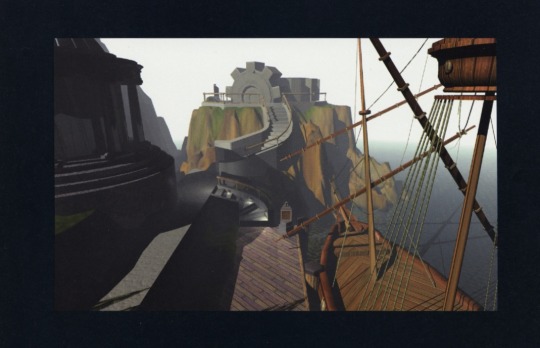

"I realized, the moment I fell into the fissure, that the Book would not be destroyed as I had planned. It continued falling into that starry expanse, of which I had only a fleeting glimpse. I tried to speculate where it might have landed, but I must admit that such conjecture is futile. Still, questions about whose hands might one day hold my mystery book are unsettling to me. I know my apprehensions might never be allayed, and so I close, realizing that perhaps the ending has not yet been written." ~ Atrus
4 notes
·
View notes
Text

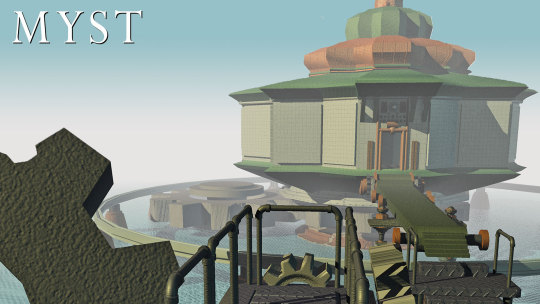

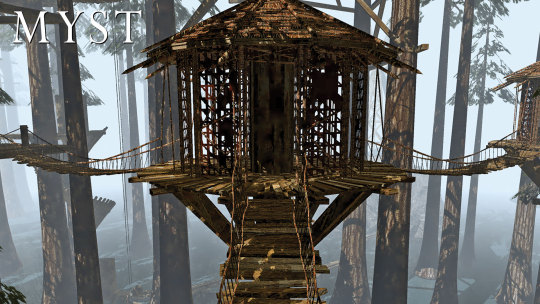
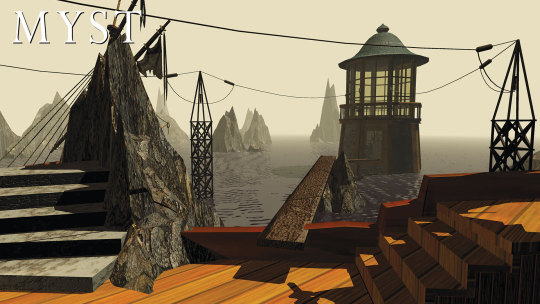
Behold the Fab Five Myst Masterpieces – one from each Age, plus the mandatory Iconic Myst Island view (which is my favorite)
Official Myst Wallpapers from Cyan
0 notes
Text
Are you into reading?
Because I am, like really into it.
I'm all about Myst's epic saga – those books transport you to a whole new world (and I mean literally).
It's like real books, but with a teleportation twist.
And guess what?
I'm about to drop a link to a book (pdf format) that talks about a game with books that have a serious case of wanderlust.
Check out "Myst & Riven, The World of the D'ni" by Mark J. P. Wolf – because who doesn't love a good read?
18 notes
·
View notes
Text
-Myst- Masterpiece Edition
The beginning:
Sure, this might not be the 'right' way to ace the game, but watch this video for those moments when cracking the riddle feels like trying to find your keys in a black hole – it might just save your sanity!
0 notes
Text

Hello!
Oh wait, you don't know me yet!
Welcome to my page, where I attempt to unravel the mysteries of Myst without getting lost in the age of questionable fashion choices and perplexing puzzle logic.
It's like trying to find the plot in a Choose Your Own Adventure book written by someone with a confusing sense of humor.
Let the journey through surreal landscapes and head-scratching riddles begin!
1 note
·
View note